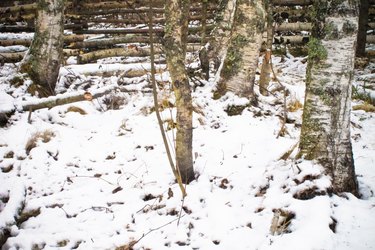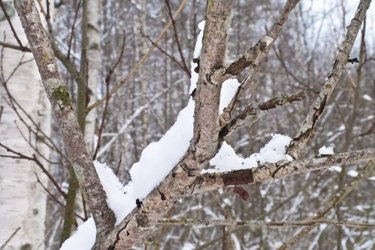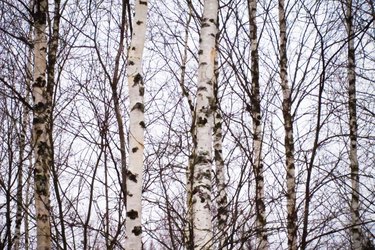Things You'll Need
Pruners
Garden saw
Rag
Denatured alcohol

If you are a gardener who loves to prune, don't select a white birch tree for your backyard. Whether you plant European white birch (Betula pendula) or paper birch (Betula papyrifera), your pruners will sit on the shelf most of the time. These trees have their own charms, however. European white birch is a fast-growing, graceful tree with creamy white bark that peels to reveal darker skin beneath. Paper birch starts life with a brown trunk that whitens as it ages. Neither tree requires regular pruning.
Step 1

Soak a rag in denatured alcohol. Clean the cutting blade with it every time you prune.
Video of the Day
Step 2

Prune your white birch only in winter. Never prune between May 1 and August 1. This is the time of activity of the bronze birch borer, an insect attracted to birch sap.
Step 3

Remove dead and dying branches by cutting off the branches at the trunk. Use a pruner for smaller branches, a saw for larger ones. Locate the branch collar, a raised section on the base of the branch. Locate the branch bark ridge on the tree trunk, just above the branch crotch. Make the cut as close as possible to the trunk without damaging either the branch collar or the branch bark ridge.
Step 4

Trim back broken or diseased branches by making the cut at a lateral branch at least 6 inches above the damaged area. Do not apply wound sealant even if the branches "weep" from the cut area, as is usually the case with birches. Disinfect the pruners between each cut when handling diseased branches.
Step 5

Thin canopy only if absolutely necessary to reduce tree height. Pruning allows more light to pass to the root zone, which warms the area and can endanger the birch. Birches grow best with sun on their leaves, but their roots in shade.
Tip
European white birch and paper birch thrive in U.S. Department of Agriculture plant hardiness zones 3 through 6 and 2 through 7 respectively.
Warning
The birch borer doesn't look dangerous. However, this small beetle can kill white birches. The adults feed on the leaves and the larvae feed on the inner wood. If your birch suffers from sparse, stunted foliage, the tree is probably infested with birch borers. Decline to death can happen very fast in a hot, dry year. Treatment with insecticides can save the tree if you apply them early enough, but after significant crown damage, the tree probably is beyond saving.
European birches propagate so readily that they are considered invasive in several states.
Video of the Day
- SelecTree: White Birch
- Friends of the Urban Forest: White Birch
- U.S. Forest Service: Grow and Maintain a Healthy Birch Tree
- Missouri Botanical Garden: Betula Pendula
- Arbor Day: Paper Birch
- U.S. Forest Service: How to Prune Trees
- Invasive Plant Atlas: European Birch
- U.S. Forest Service: Middle-aged "Youngii" European Birch
- Hortiscope: Questions on Birch